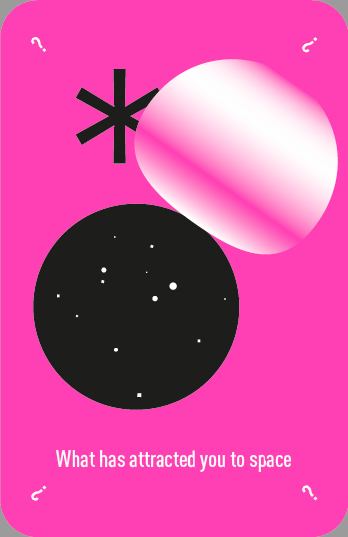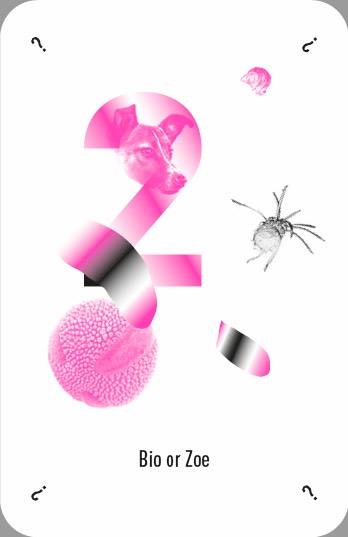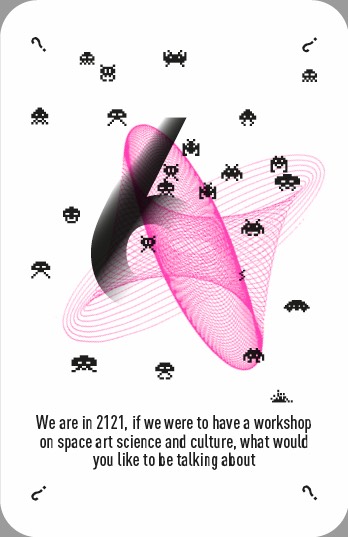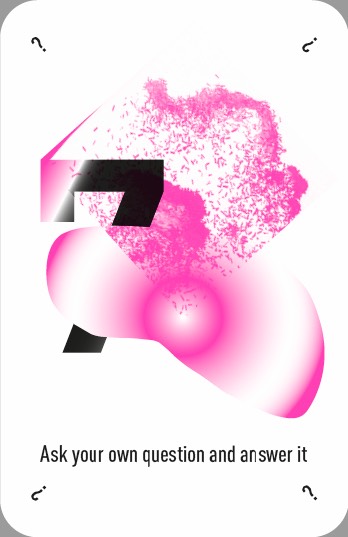
All Women Crew
Celebrating Women in Art, Astronautics and Astronomy
organised by Annick Bureaud with the contribution of Ewen Chardronnet and Susmita
Mohanty
a Leonardo/Olats Workshop
March 20 – 21 2020 – Paris
(by invitation only)
Cancelled du to Covid. However some activities were achieved remotely.
Introduction
2019 Apollo 50th anniversary has been the opportunity to dig out from the closets of history all the women that took part in the programme and contributed to the success of the Moon Landing.
2019 is also the year that saw an « all female EVA »(Extra Vehicular Activity) cancelled because there were not enough EVA space suits…suited for women onboard the ISS …
An « all women crew » still makes the headlines when it would never occur to any journalist’s mind to write about an « all men crew aboard the ISS ».
Astronomy is not doing any better that is still hugely male dominated although more and more women are starting breaking the glass ceiling. Teaming up with the FEMeeting initiated by Marta de Menezes and Dalila Honorato in Portugal in 2018, Leonardo/Olats proposes the 2020 Leonardo Space Art, Science and Culture Workshop focusing on women. FEMeeting’s main purpose is to disseminate projects that are being carried out by women in order to contribute (a) to the development of research methodologies in art and science and (b) to the development of collaboration strategies that can increase knowledge sharing and bring communities together.
This workshop does not intend to discuss the « role » of women in astronautics and astronomy nor to try to define what a « feminine approach » to space could be. Rather, totally inline with the FEMeeting, it is to give the floor to women that work in those fields be they artists, scientists, cultural players, ingeniers and in so doing making them visible and, possibly, imagining a more balanced and non patriarcal vision of/for space.
The « All Women Crew » 2020 workshop was cancelled du to Covid as we were entering the first period of lockdown. However doing things remotely is rather banal in the space activities.
We decided not to do the workshop by teleconferencing as being in co-presence is indeed at the core of those workshops. Instead we organised two remote actions: we recorded the series of podcasts as a collective remotely built contribution and we « went to the Moon » using Daniela de Paulis Visual Moonbounce technology.
Later that same year, some of the images produced with Daniela de Paulis were exhibited in the exhibition « Con(tacto) »curated by Marta de Menezes at Cultivamos Cultura in Saõ Luis Odemira, Portugal.
In 2021, we organised in Paris the public symposium « Quel corps spatial /Which Bodies in/for Space? » that included some of the women from the All Women Crew Workshop.
Curator
Annick Bureaud

Leonardo/Olats Director
Art critic and Curator
Annick Bureaud is an independent art critic, curator and event organiser in the field of art and technosciences. She wrote numerous articles and contributes to the French contemporary art magazine art press. She organised many symposia, conferences and workshops among which Visibility – Legibility of Space Art . Art and Zero Gravity: The Experience of Parabolic Flight, project in collaboration between Leonardo/Olats and the International Festival @rt Outsiders, Paris, 2003. In 2009, she co-curated the exhibition (Un)Inhabitable? Art of Extreme Environments, Festival @rt Outsiders, MEP/European House of Photography, Paris. In 2018, she curated the Bourges Bandits-Mages Festival Mending the Fabric of the World. In 2019, she published-curated the online hypertext video capsule about the artwork Neotenous Dark Dwellers – Lygophilia by Robertina Šebjanic. She is the director of Leonardo/Olats.
Participants
Participants : Yulia Akisheva | Hélène Ben Aïm Drieux | Fabiane M. Borges | Marie-Pier Boucher | Kitsou Dubois |Félicie d’Estienne d’Orves| Elizaveta Glukhova | Ségolène Guinard | Michelle Hanlon | Flis Holland | Dalila Honorato |Adriana Knouf | Minna Långström |Aoife van Linden Tol | Daniela de Paulis | Mirjana Povic | Neha Satak
Yulia Akisheva - Our Giant Leap : towards a more diverse and gender-balanced workforce of the aerospace sector

Our Giant Leap (OGL) is a forward-looking initiative of the global non-governmental, non-profit organisation and network of the Space Generation Advisory Council (SGAC) that embraces diversity and gender balance in the aerospace sector. OGL is built on three pillars: inspiration, education and community. The uniqueness of this organisation is in its proximity to the young professionals, students and senior advisors of the sector and its concretised plans to ameliorate the current state of affairs, primarily the globally low representation of women across occupations and the career ladder. This identified the main goal of OGL for 2020: focus on the women of aerospace, educate SGAC delegates about the challenges that female colleagues must overcome to start and keep working in the sector and propose solutions for various related issues. The strong points of the SGAC is that it represents the voice of the space youth on, among other, how the space workforce should develop, and their ideas are presented to the Organisation of the United Nations in support of the United Nations Programme on Space Applications.
Women of the sector often learn to overlook the stigma of discrimination and accept it as the burden of traditionally male dominated work field but as we look into the future of space, at OGL we see the need for change. However, fighting discrimination is not the lone objective of OGL. The community aims to inspire young women to choose the path of science, technology, engineering and research; propose mentorship strategies for young space professionals in academia, industry and space agencies; find solutions to concrete issues raised by members, i.e. pay gap and maternity/paternity leave and come back.
An expected outcome of the activities held through networking and uniting international communities is a set of recommendations and step-by-step strategies as well as descriptions of trainings to be held in companies, non-profits, academia and space agencies. The goal is to make these documents accessible to the Human Resources of such entities and all members of the OGL’s network.
OGL offers a system, a networking platform for the space sector to utilise in order to break stereotypes and embrace diversity for the full palette of opportunity and ingenuity that it presents. There is no doubt about diversity being the bright way for space workforce development to follow. A significant step, or leap, of the way is valorising women of the sector.
Yulia Akisheva

Cockpit Operations Research Engineer at Alten
Event Manager of SG[France]2020-Our Giant Leap at SGAC
Two nationalities, Russian and Swedish; three Master’s degrees, and 25 years of age make one aerospace engineer and young scientist. In space, I am above all passionate about human exploration of Mars and international collaboration. Born in 1994, I am at the beginning of my career path but its Martian roots go far back and it has already been a journey for me to get here.
Precisely, 10804 km of aspirations, dreams, limitations, failures and successes. Apparently, a space trip is a bumpy ride.
My roots stretch back to Khabarovsk a Far Eastern city in Russia so far from the space industry, I hid my space dream so deep that not a single person knew of my passion until 18 years later, already in Stockholm, Sweden, after I had applied exclusively for Aerospace Engineering at KTH. Having evolved from someone who had once buried her dream to dig it back up half way around the globe to somebody friends call « the Mars girl », I would like to tell you never to give up on your dreams.
You know, there are many severe dust storms on Mars, but remember to dust off your dream and remind yourself of what it was before the storm; my enduring dream is to contribute to the international human exploration of Mars. Nurture your dreams, in many ways they make us who we are.
Hélène Ben Aïm Drieux - Prepare future space skills through open innovation

Preparing for the future today and staying an expert tomorrow are survival challenges for all hig-tech companies.
Space techniques do not escape this requirement of continuous evolution of its know-how to always go further beyond the limits of exploration.
Thanks to social networks, the dissemination of knowledge becomes universal and within the reach of any brain ready to enrich it. Open source also allows everyone to be a source of innovation, which exponentially increases the speed of appearance of new materials, processes and uses: knowledge that you must capture, understand and adapt for our own needs.
Through its experts networks in open innovation, CNES plans to benefit from the knowledge and feedback from large communities to maintain its highest level of expertise
Hélène Ben Aïm Drieux

PhD Engineer – Open Innovation Project Manager – CNES
Hélène Ben Aim Drieux is a « Maker ». Whatever the issues that are entrusted to her, she provides end-to-end solutions. Expert, project manager, auditor, strategic plan manager, or space representative in a ministerial office … enforced by 30 years of experience at CNES, she’s been responsible for open innovation for 7 years. Hélène’s Project COMET strengthens the skills and know-how of some 5000 experts in networks including 800 CNES engineers. The goal is to keep all of them at their highest technical levels, to face the current exponential increase of knowledge. Being pragmatic and collaborative, Helene implements frugal concrete solutions using the « test and learn » methodology. His motto: « the best is the enemy of good ». Convinced of the richness of diversity, she is Chairwoman of the Paris group of « Women in Aerospace Europe ».
Engineer (INSA 1984), PHD in Physics (INPT 1990), Auditor (IFACI, 1997), High military studies (SHEAR2000) Green Belt Lean (2017), trained facilitator and creative methods
@LinkedIn H.BenAim – @COMET – @WIA-E
Fabiane Borges - SACI-E / INPE - Subjectivity, Art, Space Science - A Space Culture Platform and Art Residency in the National Institute for Space Research / Brazil.
SACI-E / INPE - Subjectivity, Art, Space Science - A Space Culture Platform and Art Residency in the National Institute for Space Research / Brazil.

The first brasilian indigenous astronomer talking in the II Intergalactic Commune Picture: Rafael Frazão
A talk about SACI-E / INPE platform (Subjectivity, Art, Science – Space at the National Institute for Space Research) in Brazil. The idea is to present some concepts that guided the creation of the platform, the process of institutional convincing, the first artistic residencies, the relationship between SACIE and CGETE (General Coordination of Space Engineering and Technology), which was the department that adopted the platform – that is connected with all other departments, the participation of SACI-E in the Cubedesign festival (nanosatellites competition) that will incorporate the ARTSAT as category for the first time in July 2020. At this current moment, it is also important to discuss the participation of emerging (or peripheral) countries in the space theme, as well as the culture of colonization imposed on these programs. At this point, there will be a short introduction to the festivals of the « Comuna Intergaláctica », a festival that brings together art and science with indigenous, quilombola and gender research, among other socio-cultural policies.
Fabiane Borges
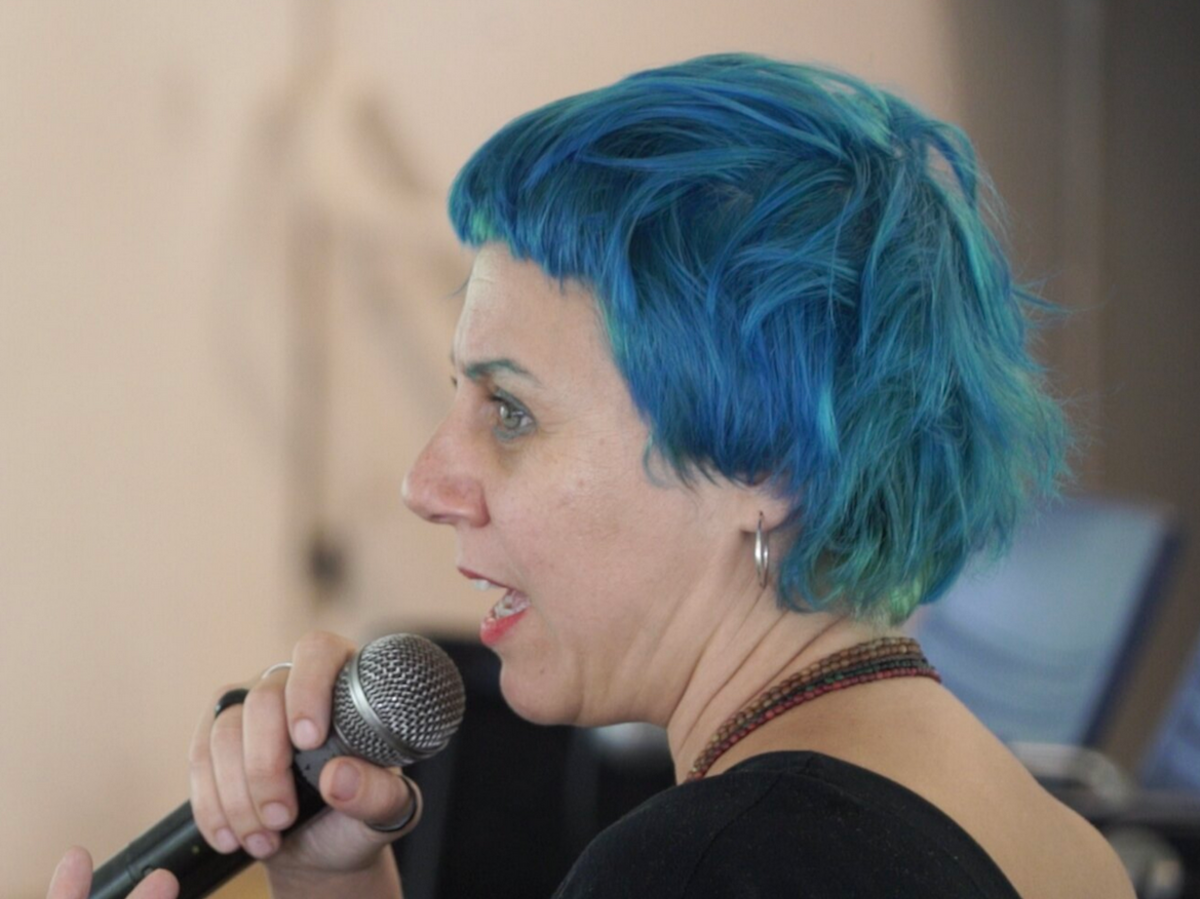
Doctor in Clinic Psychologyst – PUC/SP & Post-phd fellow at PGETE/INPE / Director of Space/Art Platform SACI-E/INPE/Brazil
Fabiane M. Borges is an articulator of the Technoshamanism and Intergalactic Commune network. She is a graduate, master and doctor in Clinical Psychology, a researcher who works at the intersection between Subjectivity, Art, Science and Technology. In 2015 she was curator and organizer with Pedro Soler of the « Art in Orbit » exhibition at the Museum of Contemporary Art in Quito / Ecuador. She is Director and Curator of the SACI-E / INPE Platform – A platform for Space Culture and Artistic Residencies at the National Institute for Space Research / Brazil.
https://sacieartscience.wordpress.com/
http://tecnoxamanismo.wordpress.com
Marie-Pier Boucher - Time beyond gravity

Ale de la Puente, An Infinity without Destiny , 2015. Image: courtesy of the artist.
Marie-Pier Boucher

Assistant professor of Media Studies at the University of Toronto, Canada
Marie-Pier Boucher research focuses on the design of habitats for sustaining life in extreme environments. She is the co-editor de Being Material (MIT Press, 2019), Heteropolis (2013), and Adaptative Actions (Madrid, 2010). She is a collaborator of the plateform Adaptative Actions. She has taken part in group exhibitions in Tokyo Wonder Site (TWS), Japan, 2015; Galerie d’art Leonard & Bina Ellen, Montréal, 2010; Biennale Madrid Abierto, Spain, 2010). Her research residencies include: Banff Center, Canada (2011), Max Planck Institue for the History of Sciences, Germany (2010) and SymbioticA, Center for excellence in bioart, Australia (2006). She is assistant professor of Media Studies at the University of Toronto, Canada.
https://www.instagram.com/adaptiveactions/?hl=en
http://adaptativeactions.net
Kitsou Dubois - Choreographic writing from experiments in microgravity

Kitsou Dubois en vol parabolique © K. Dubois
My artistic approach as a choreographer and a dance researcher is about revisiting the fundamental movements of dance within the experience of another time-space continuum: microgravity. Thanks to about 20 parabolic flights I have been in, with about 15 dancers and circus artists, I was able to develop a knowledge of mechanisms and movement in microgravity and create a choreographic writing on the ground, which integrates this other point of view on movement.
So I work on the state of the body as revealed by the experience of weightless movement, or in environments where gravity is altered: parabolic flights (at the French National Center for Space Studies), water and with new technology. I have been wondering what our relationships to others may be in the absence of gravity. What points of support we can find, reinvent and reimagine? What is the nature of body memory disconnected from weight? How can we share these emotions? My pieces and video installations are an attempt to answer these questions.
During this workshop, I will try to make legible for the audience another form of thought generated by human experience of outer space in an artistic approach of the moving body on earth.
Kitsou Dubois
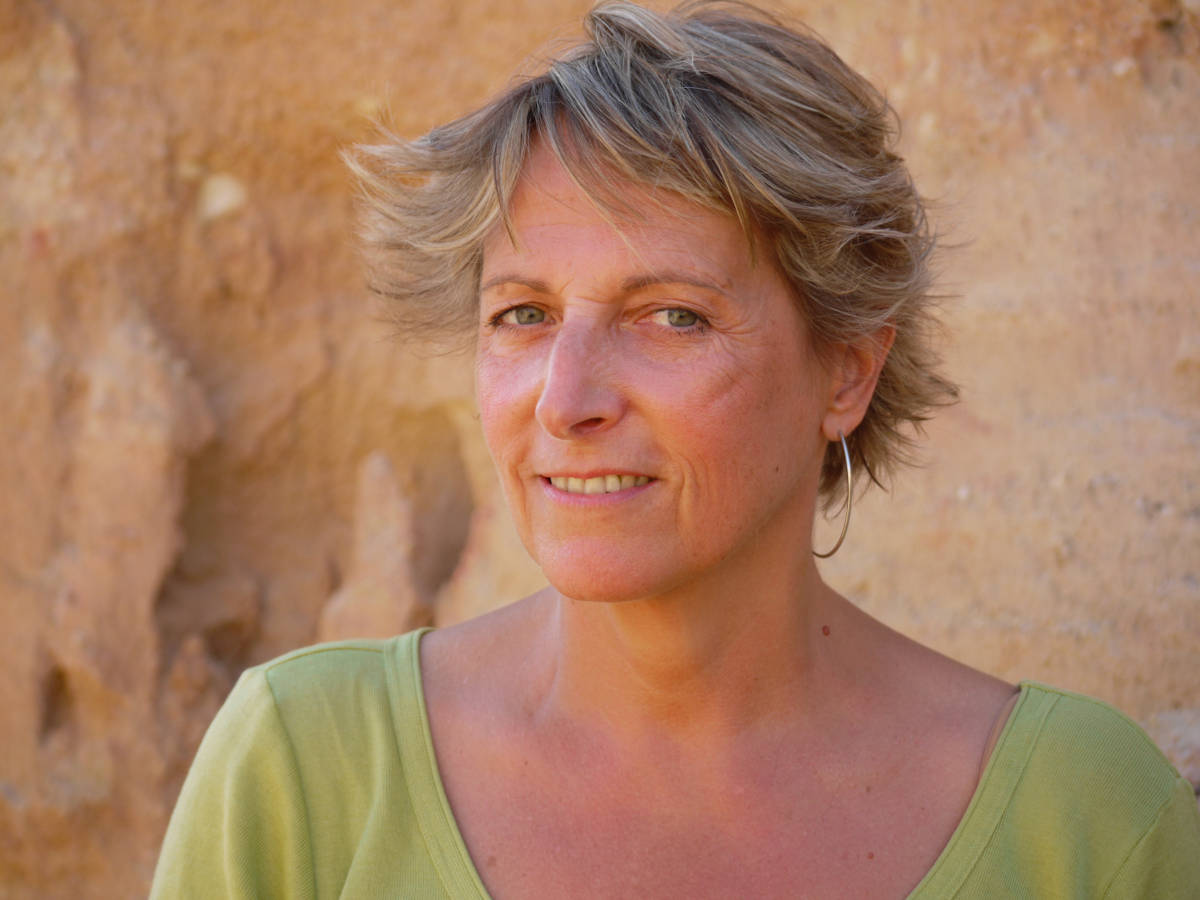
Kitsou Dubois, image © Diane Delehaye
French Choreographer, Dance Researcher, Artistic Director of « Ki Productions »
In 1990, Kitsou Dubois, choreographer and researcher in dance, became the first artist to experience weightlessness in parabolic flight with the French Space Agency (CNES). Since then, Kitsou has flown on a series of 21 parabolic flights.
In her creations, from stage choreographies to video installations or hybrid productions, Kitsou uses her experience and knowledge of weightlessness to explore movement, perception of the environment and also the sensation of time, the relation to matter, the relation to others and the poetry of an environment where all familiar references seem to have been transformed.
She works with performers (dancers and acrobats) in environments where the sensation of gravity has been altered: in water, in parabolic flights, in virtual reality set-ups (with sound and sensorial sensors) and also works closely with researchers in science and technology.
In her artistic approach, she works, from the dance gesture perspective, on the legibility of another space-time « nor heavy, nor light ». She made dream-like pieces which trouble the perception of the audience. Movements alternate between losing point of reference and anchoring. A connection is made between the bodies of the dancers and that of the spectators, uniting both in a common vertigo.
Félicie d'Estienne d'Orves - Deep field
Félicie d'Estienne d'Orves

Artist
The work of Félicie d’Estienne d’Orves combines light, sculpture and new technologies. Her research focuses on vision, its processes and conditioning. Her immersive installations use a phenomenological approach to reality, they underscore the perception of time as a continuum. Since 2014, the artist’ researches focused on space in relation to astrophysics and to study the natural light cycles.
Her work has been shown at the Centre Pompidou – Nuit Blanche (Paris) – New Art Space / Sonic Acts (Amsterdam) – Watermans Arts Center (London) – Elektra Festival / BIAN (Montreal) – Maison des Arts of Créteil (Créteil/FR) – Le Centquatre / Nemo International Biennial of Digital Arts (Paris) – OCAT (Shanghai) – ICAS (Dresden) – Aram Art Museum (Goyang /KR).
Elizaveta Glukhova - Moon Gallery: Think Big, but Small

Moon Gallery during the analog & simulation campaign EMMIHS-II, HI-SEAS, Hawaii. Image by EMMIHS-II crew.
Anna Sitnikova (1, 2, 4), Elizaveta Glukhova (1, 2, 4), Bernard Foing (1, 2, 3) and Moon Gallery team (1) Moon Gallery (art@moongallery.eu), (2) ILEWG International Lunar Exploration Working Group (3) ESA ESTEC, (4) KABK Royal Academy of Art
Moon Gallery is an international collaborative artwork and a gallery of ideas worth sending to the Moon. Moon Gallery intends to launch 100 artefacts to the Moon within the compact format of a 10 x 10 x 1cm plate on a lunar lander as early as 2022. In this Petri dish-like gallery we are developing a culture for future interplanetary society. What are the ideas we want to promote into the future? What are the ideas we want to leave behind?
Moon Gallery as a pilot platform within the framework of the Moon Village, ITACCUS & ILEWG aims to instigate inspiration for the global space exploration and demonstrate how the challenges along this journey drive innovative design thinking and interdisciplinary collaborations. Art Moon Mars collective leads this project, coordinates events and develops content through a series of open calls.
We invite art projects and artefacts, inspired by the Moon and human exploration. One of the biggest challenges of space exploration is a disparity between big ideas and resources for their realization. We ask our participants to think big but small. Each idea has to fit within just 1 cubic cm. To answer this challenge we strongly encourage interdisciplinary cooperation: bridging engineering, science and art together.
Mission Statement:
We hope to bring the best of humanity to the Moon, and to bring the benefits of the Moon to all people on Earth through a sustainable exploration process. Our initiatives connect Art, Moon, Mars and beyond. This includes the organisation of meetings, workshops, art science space classes and projects at various universities, sessions at international conferences, art exhibitions, musical and visual performances, and art science space platform – Moon gallery.
Miniature artworks – payloads will serve as seeds of new culture, designed to inhabit and make the Moon a more habitable place. Each piece is a part of a collaborative artwork and an evolving shared vision of Moon Gallery:
What would be our new values and ideals, aesthetics in space based on lessons learnt on Earth? How for example sculpture would work in 1/6th gravity? And how our bodies and perception of beauty will change (while our bodies adapt to new conditions)? How would we perceive colours without the atmosphere? Which new art forms will sprout?
Relevance/significance:
– promoting cooperation: bridging innovation, science and art, crossover with space research, developing a space art experiment;
– stimulating research: collective reflection on artistic heritage, analysis – how to design for space (1/6th gravity, extreme environment);
– promoting artistic quality: offering artists follow up opportunities involving space science expertise;
– reinforcing international position of artistic practice: « International cooperation towards a world strategy for the exploration and utilization of the Moon – our natural satellite » (International Lunar Workshop, Beatenberg (CH), June 1994);
– exemplary commissioning: follow professional process – idea – concept – feasibility – pilot project – Earth prototype – Moon Gallery commission for space.
Acknowledgements:
We acknowledge Alexander Zaklynsky contribution to the project research, development and production. We acknowledge Moon Gallery artists, and in particular: Mary Kuiper, Jorick de Quaasteniet, Jamal Ageli and Ronald Vles for support in Moon Gallery events.
Elizaveta Glukhova

Researcher and media artist
Elizaveta Glukhova is a researcher and a media artist. She studied applied arts at the Moscow State Stroganov Academy of Industrial and Applied Arts. In 2014 she continued her education at the Graphic Design department of the Royal Academy of Art in
The Hague, from where she graduated in 2018. She considers herself a curator of ideas and a storyteller and implements this approach to her autonomous as well as applied practice.
At the end of 2018 Elizaveta joined the ArtMoonMars group and became a co-curator of the Moon Gallery (www.moongallery.eu) project. Together with Anna Sitnikova and Bernard Foing, she works on the promotion of interdisciplinary collaborations and innovative design thinking inspired by the challenges of human space exploration.
Ségolène Guinard - Of Space Gardens and space gardeners. Towards a cosmicology.

Capture of Alexander Kaleri on Mir station during the harvest of salad crops in the SVET greenhouse, April 2000, courtesy of IBMP and Nasa Kennedy Space Center
» It was at the begining of my second mission on the ISS and there was a small greenhouse, when these vegetal ecosystems stated to be implemented on the station (..) I remember we were trying to scrounge some extra time at night to look at the window and enjoy all these sensations that did not belong to work – I remember crossing the station at night to enjoy the view, and I came across my collegue Yuri.
He had been on the station for six month and instead of staying at the window and looking at the Earth, he used to hang by the greenhouse – and you could see how much he was attracted and pleased, and how he longed for it. I would have never imagined that ! I mean, that you could be fascinated by those lettuces ! But well, there he was. I used to go and gaze at the Earth and he used to gaze at the growing lettuce. So when you mentioned those relationships we have with non humans, I immediately thought about Yuri watching his lettuce grow at night. » (Interview with a French female astronaut, Paris, 2015)
As they do on Earth, gardens in space provide fresh food and host companion species (as well as more threatening species like microbes and fungi) and, as seminal anthropological works have shown, they are also scenes where natureculture continuity and ontological assumptions are staged. In space their magic lies in their power to give their fellow astronauts a sense (and senses) of their Earth home. Gardens’ leafy inhabitants are different from the plants sent up there as pure objects of science as they are mostly open systems, in direct contacts with astronauts who can smell them, eat them, water them and monitor their health. Of course, daily schedules, mission goals, microbes tracking, and the overall tightly controlled environment a space station is, put restrictions on this companionship. Yet, unlike their corporate counterparts on Earth (vertical farming, aeroponic towers, plants-in-computers), their marginal survival and discreet presence are still depending on the subtle care and attention of their fellow human gardeners, on the ground and in space. In the estranged and hostile world a space station is, gardens are fragile, but none of the space gardeners I met envision long missions without those beings rooting their companion humans back home. Echoing the recent awareness of human and more-than-human entanglements, outer space is no exception for the study of planthuman contacts. Many of the space gardeners I interviewed experience plant life as sensitive, unique, fragile and yet robust. It is in the formes-de-vie (Agamben, 2015) flourishing when humans and plants are in contact and in spite of the dense web of systems they are enmeshed with, that I found the resources to start deconstructing the capsule as a self-sufficient, future-oriented, closed-loop simulacre and notice how cosmicology (cosmos-oriented ecology) could also take place there. My research on « artificial » ecologies in space has materialized a world where there is no stable and inert world lying under us. The loop is entirely composed of « people, » (Danowski & Castro, 2014) Humans and Earth others alike, (Plumwood, 2002), whose slightest actions can significantly alter the whole stuff this world is made of – each one sharing the responsibility of sustaining the existence of all the others, each one being a gardener for the other.
That finding should also advocate against metaphors of the spaceship Earth where humans are the ultimate pilots and gardeners. It also tries to dismantle the idea of Space as a vacuum open to conquest and think of cosmic entities connected to the web of lives on Earth (Benjamin, 1978), thus engaging critically with western science and technological infrastructures.
Agamben, Giorgio. L’Usage des corps. Homo sacer IV 2. Paris: Le Seuil, 2015.
Benjamin, Walter. » Vers le planetarium » in Sens unique. Paris: Maurice Nadeau, 1978.
Danowski, Deborah & Viveiros de Castro, Eduardo (2015) » L’arrêt de monde » in Hache, Emilie, ed. (2015), De l’univers Clos Au Monde Infini. Editions Dehors.
Descola, Philippe. La nature domestique: Symbolisme et praxis dans l’écologie des Achuar. Les Editions de la MSH, 2015.
Myers Natasha (2017) » From the Anthropocene to the Planthroposcene: Designing Gardens for Plant/People Involution « , History and Anthropology.
Olson, Valerie A. (2018), Into the Extreme, Minnapolis : University of Minnesota Press.
Plumwood, Val (2002), Feminism and the Mastery of Nature. 1st edition. Routledge.
Povinelli, Elizabeth A. (2016), Geontologies. Durham N.C.: Duke University Press.
Ségolène Guinard

Ph.D Candidate in Philosophy, University Paris 8 Vincennes Saint-Denis
Michelle Hanlon - Preserving Human History in Space - a Path to Sustainable Development and Peace
Michelle is the Co-Director of the Air and Space Law Program at the University of Mississippi School of Law and its Center for Air and Space Law. Preserving Human History in Space – a Path to Sustainable Development and Peace She is also a Co-Founder and President of For All Moonkind, Inc., a nonprofit corporation that is the only organization in the world focused on protecting human cultural heritage in outer space. For All Moonkind has been recognized by the United Nations as a Permanent Observer to the United Nations Committee on the Peaceful Uses of Outer Space. Michelle Chairs the International Committee of the National Space Society and serves as the Co-Chair of the Cultural Considerations Working Group of the Moon Village Association. She received her B.A. in Political Science from Yale College and her J.D. magna cum laude from the Georgetown University Law Center. Michelle earned her LLM in Air and Space Law from McGill University where the focus of her research was commercial space and the intersection of commerce and public law. Prior to focusing on space law, Michelle was engaged in a private business law practice. Her legal career commenced with the restructuring of sovereign debt for a number of South and Latin American countries and evolved into the negotiation and implementation of cross-border technology mergers and acquisitions. Her subsequent solo practice advised entrepreneurs across four continents on all aspects of bringing their innovative ideas to market: from basic corporate formation to financings and buyouts. Michelle continues to provide advice and counsel in respect of all aspects of air, space and cyber law through the consulting firm of ABH Aerospace, LLC.
Michelle Hanlon
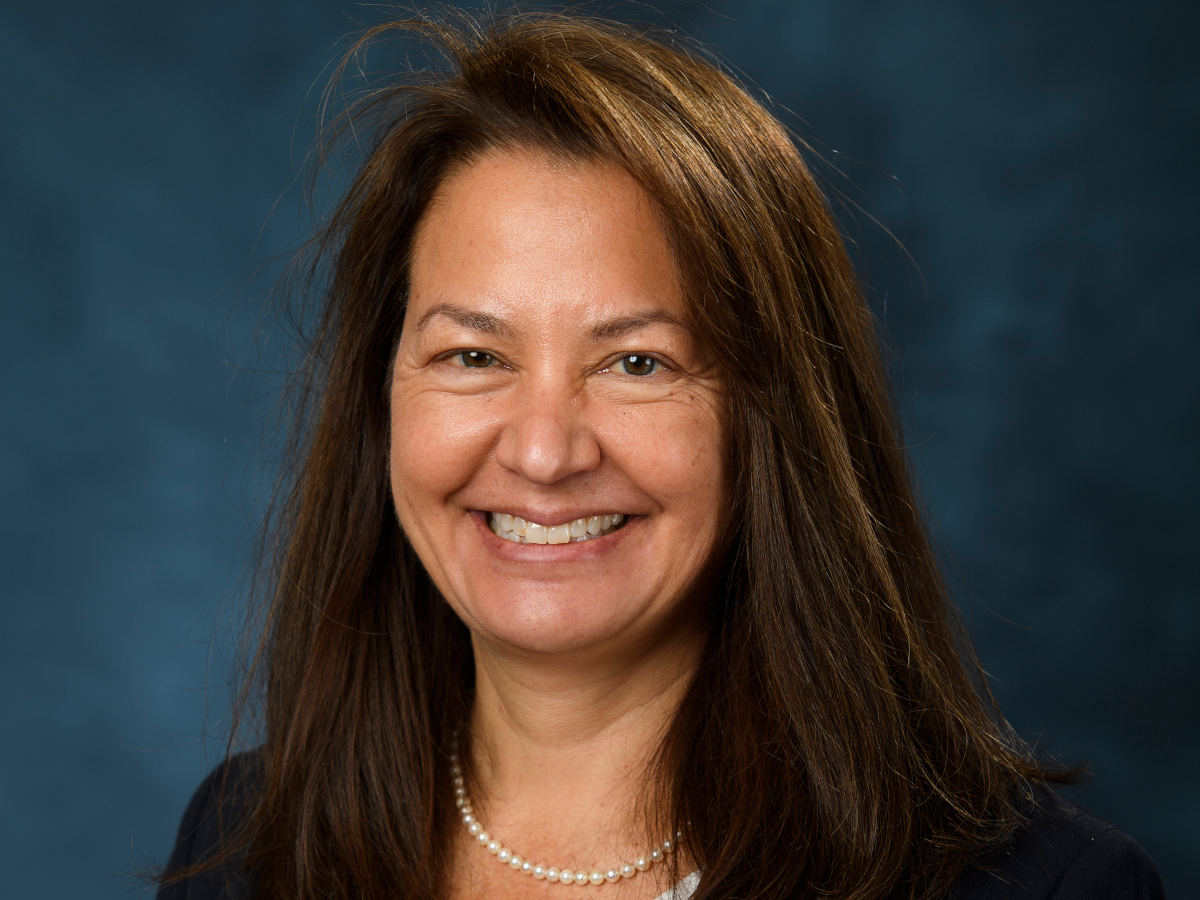
Co-Founder and President, For All Moonkind and Co-Director at the Center for Air and Space Law at the University of Mississippi
Michelle is the Co-Director of the Air and Space Law Program at the University of Mississippi School of Law and its Center for Air and Space Law. Preserving Human History in Space – a Path to Sustainable Development and Peace She is also a Co-Founder and President of For All Moonkind, Inc., a nonprofit corporation that is the only organization in the world focused on protecting human cultural heritage in outer space. For All Moonkind has been recognized by the United Nations as a Permanent Observer to the United Nations Committee on the Peaceful Uses of Outer Space. Michelle Chairs the International Committee of the National Space Society and serves as the Co-Chair of the Cultural Considerations Working Group of the Moon Village Association. She received her B.A. in Political Science from Yale College and her J.D. magna cum laude from the Georgetown University Law Center. Michelle earned her LLM in Air and Space Law from McGill University where the focus of her research was commercial space and the intersection of commerce and public law. Prior to focusing on space law, Michelle was engaged in a private business law practice. Her legal career commenced with the restructuring of sovereign debt for a number of South and Latin American countries and evolved into the negotiation and implementation of cross-border technology mergers and acquisitions. Her subsequent solo practice advised entrepreneurs across four continents on all aspects of bringing their innovative ideas to market: from basic corporate formation to financings and buyouts. Michelle continues to provide advice and counsel in respect of all aspects of air, space and cyber law through the consulting firm of ABH Aerospace, LLC.
forallmoonkind.org
Flis Holland - Gravity doesn't keep you down I do

Gravity doesn't keep you down I do (2019), Kosminen, Helsinki. Photo credit: Helen Korpak
My latest performance is a network of simulated disasters, self-harm and limited empathy. Revisiting my (short-lived) career as an engineer of asteroid defence systems, I link it to my current work on depression. Two wildly differing takes on what a crisis is, and what survival looks like.
Flis Holland

Artist, Finnish Academy of Fine Arts
I practise depression and I’m trying to get worse at it. I’m a doctoral candidate at the Finnish Academy of Fine Arts, a Finn Brit, a slow writer. My short story Sigh-fi was published in Kontur journal’s ‘Decline’ issue (link above). I spent 2019 developing an iterative performance ‘Gravity doesn’t keep you down I do’, which culminated in a New York residency to research asteroid strike simulations.
http://www.instagram.com/fiilisholland
https://soundcloud.com/felholne/sigh-fi-19m
Dalila Honorato - "Mars ain't the kind of place to raise your kids"

My first memories of space are marked by Ellen Ripley, the protagonist of the Alien saga. Marked by the fright, the stubbornness, the resilience, the stickiness and the goop of a woman in face of a parasitical extraterrestrial life growing inside of her just to rip her apart. My idea of space forever linked with feeling lonesomeness and emptiness but also a strong sense of connection and ability to sacrifice and survive. As, more recently, Ryan Stone, the main character in the film Gravity, reminded me how the outer space might just be the closest place to find humanity, either when confronted with an alien being, a natural disaster or isolation. Ryan who also took me back to the imaging of Lennart Nilsson in A Child is Born, while she is wandering in space and curiously reflecting on the death of her child on Earth. Meanwhile, last year, SpaceLife Origin, a Netherlands-based startup dedicated to off-world reproduction, suspended, until further notice, its plan to send a pregnant volunteer to give birth in space, and, as it seems, « I think it’s gonna be a long long time ».
Dalila Honorato

InArts Lab – Ionian University
Dalila Honorato, Ph.D is Tenured Assistant Professor in Aesthetics and Visual Semiotics at the Ionian University, Greece. One of the founding members of the Interactive Arts Lab, where she coordinates the Art & Science Research Group, she is also a collaborator at the Center of Philosophy of Sciences – University of Lisbon. Her research focus is on embodiment, monstrosity, the uncanny and the acrobatic balance between phobia and paraphilia. The starter of the conference « Taboo-Transgression-Transcendence in Art & Science », Dalila Honorato launched together with Marta de Menezes « FEMeeting: Women in Art, Science and Technology ».
https://inarts.eu/en/lab/staff/honorato/
https://femeeting.com
Adriana Knouf - Tranxxeno Entanglements: On the Audacity of Imagining Transgender People in Space
Tranxxeno Entanglements: On the Audacity of Imagining Transgender People in Space

Knouf-Adriana, "TX-1", image courtesy of the artist
As far as we know there have been no transgender people in space. Yet transgender people, as well as others who engage in extensive body modification necessary for survival such as disabled folx, might be the most suited for space travel given our somatic experiences of deep xenological transformations. Such transformations will likely be required for survival and thriving both in extraterrestrial as well as future terrestrial environments. I am exploring these issues through projects in my newly launched tranxxeno lab, a nomadic artistic research laboratory that investigates the productive entanglements between entities trans and xeno. The first project, entitled TX-1, will launch fragments of my hormone replacement medications to the International Space Station and will mark the first-known time that elements of the transgender experience orbit the earth. TX-1 will ultimately return to the surface of the earth, hopefully intact. This is a symbolic exodus from a planet that is often inhospitable to us, yet its return is a sign of resilience, of not simply being discarded as burnable waste. The project leads us to consider the audacity of queer and transgender futures in space, questions of more-than-human enhancement that connect to the historical legacy of the cyborg, and are part of my research into xenology, or the study, analysis, and development of the strange, the alien, the other.

Adriana Knouf
Artist/Writer/Xenologist; Assistant Professor of Art + Design, Northeastern University
Adriana Knouf (she/her/hers, sie/hir/hirs) works as a xenologist, as an artist-scientist-writer-designer-engineer. She engages with topics such as space art, satellites, radio transmission, non-human encounters, drone flight, queer and trans futurities, machine learning, the voice, and papermaking. She is the Founding Facilitator of the tranxxeno lab (https://tranxxenolab.net), a nomadic artistic research laboratory that promotes entanglements amongst entities trans and xeno. Adriana is also an Assistant Professor of Art + Design at Northeastern University, Boston, MA, USA.
Adriana publishes widely, including a book, _How Noise Matters to Finance_ (University of Minnesota Press, 2016); journal articles about radio art and xenological temporalities; book chapters about biohacking and the intersection of handpapermaking and electronics; and conference papers about surveillance, xenology, and human-computer interaction. Adriana’s research has been supported by residencies such as Field_Notes and Wave Farm. She exhibits nationally and internationally and regularly presents at conferences and festivals around the world. For more information see http://zeitkunst.org.
Minna Långström - A Mars Exploration Into the Image - the background research of the film "The Other Side of Mars"
A Mars Exploration Into the Image - the background research of the film "The Other Side of Mars"

"The Other Side of Mars", image courtesy of napafilms ltd
The recent documentary « The Other Side of Mars » presents a discussion about the virtuality and materiality of images, in the context of Nasa’s Mars missions and related imagery. Witnessing the Mars Science Laboratory researchers’ close-up engagement with the Martian terrain during the making of the film brought about questions about the promises and limits of photography, interpretation of an inaccessible place via 2D-imagery, the role of perception, and the scientific value of imaging.
The first photographic meeting with the Martian surface took place just decades ago, and although there were reliable data evidence of Martian atmosphere and surface conditions speaking against these life forms, it took an orbital photograph to finally settle the last remaining ambiguities on this issue. The history of the exploration of Mars, in particular, is full of assumptions colored by our desires, which by no means ended with the first (telescope or spacecraft) photographic images of the planet.
From the early days of Martian photography, cameras and other photographic technology has become an increasingly pervasive part of the various kinds of tools the spacecraft are equipped with. Today NASA has whole units devoted to scientific photography, and the various applications of images as increasingly complex tools makes imaging itself emerge as a science in its own right. The background research and the material accumulated during the production of the film on Martian photography can also support a larger discussion about our past, present and future relationship to images in general. Several of the researchers and engineers interviewed for the film are female, and part of the background research was devoted into the history of women in Astronomy and space exploration, and what the circumstances are like today for women in these fields.

Artist filmmaker, MFA
Minna Långström is a media artist and film maker from Helsinki, Finland. Her artistic work consists of participatory cinematic installations, short films and documentaries. Her work processes tend to be extensively researched and interdisciplinary. Her latest film « The Other Side of Mars » (56 min, 2019) brought her in contact with geologists, astrobiologists and Nasa engineers involved with the current Mars missions. Premiering at the DocPoint Documentary Film Festival 2019, and screened at festivals around the world, the film looks at the role of images in these missions. Her previous films and artwork have been selected to numerous film festivals and exhibited at museums such as Kiasma Museum of Contemporary Art and Frankfurter Kunstverein and in galleries such as InterAccess gallery in Toronto. Långström was an assistant professor in Moving Image at the Academy of Fine Art in Helsinki 2008-2012, where she also developed course concepts critically connecting media art, science and technology. She has been an artist in residency at FACT, Liverpool, IASPIS, Stockholm and Space Studios for Art and Technology in London.
http://www.minnalangstrom.net/
https://napafilms.fi/mars-kuvien-takaa-the-other-side-of-mars-2019/
Aoife van Linden Tol - Rules of Engagement

Borrowing from the military meaning of the phrase, Aoife van Linden Tol will discuss how an artist or facilitator of an experience you effectively write your own ‘rules of engagement’ for each project, performance, work or workshop. Who and why you engage and what the outcome might be are dictated by you. Aoife will examine the motivations, parameters responsibilities for engaging audiences using examples of different approaches she has used and why. Opening for discussion ideas of responsibility as well as understanding the public face of a project vs it’s hidden motivations.
Aoife van Linden Tol

Artist, Vice Chair ITACCUS
Aoife van Linden Tol is a London based artist working with explosives. Beginning in 2000 her work with explosives fuses her interests in nature, cosmology, chemistry and physics. She is a multi-disciplinary artist whose practice spans sculpture, installation, drawing, photography, film and performance. She creates abstract, visceral and immersive works which often examine concepts of time, density and matter as well as deep human emotions and motivations.
Aoife is the Director of FERAL, an arts and events organisation which tunes into the wild and beautiful instincts of the human condition. She graduated from Central St Martins College of Art and Design, with BA Hons in Art & Design. She also graduated from The International School for Safety and Explosive Engineers with a national qualification in explosive handling 2001. She was was awarded the position of Artist in Residence at the European Space Agency & Ars Electronica Futurelab during 2017. Some of her other roles include Fellow of the Royal Society of Arts and the Vice Chair for the IAF Committee for the Cultural Utilisation of Space.
Daniela de Paulis - Artistic Research on Radio

I will be talking about my experience in working as an artist in collaboration with radio operators, focusing on the experimental approach of my practice and the challenges faced.
Daniela de Paulis
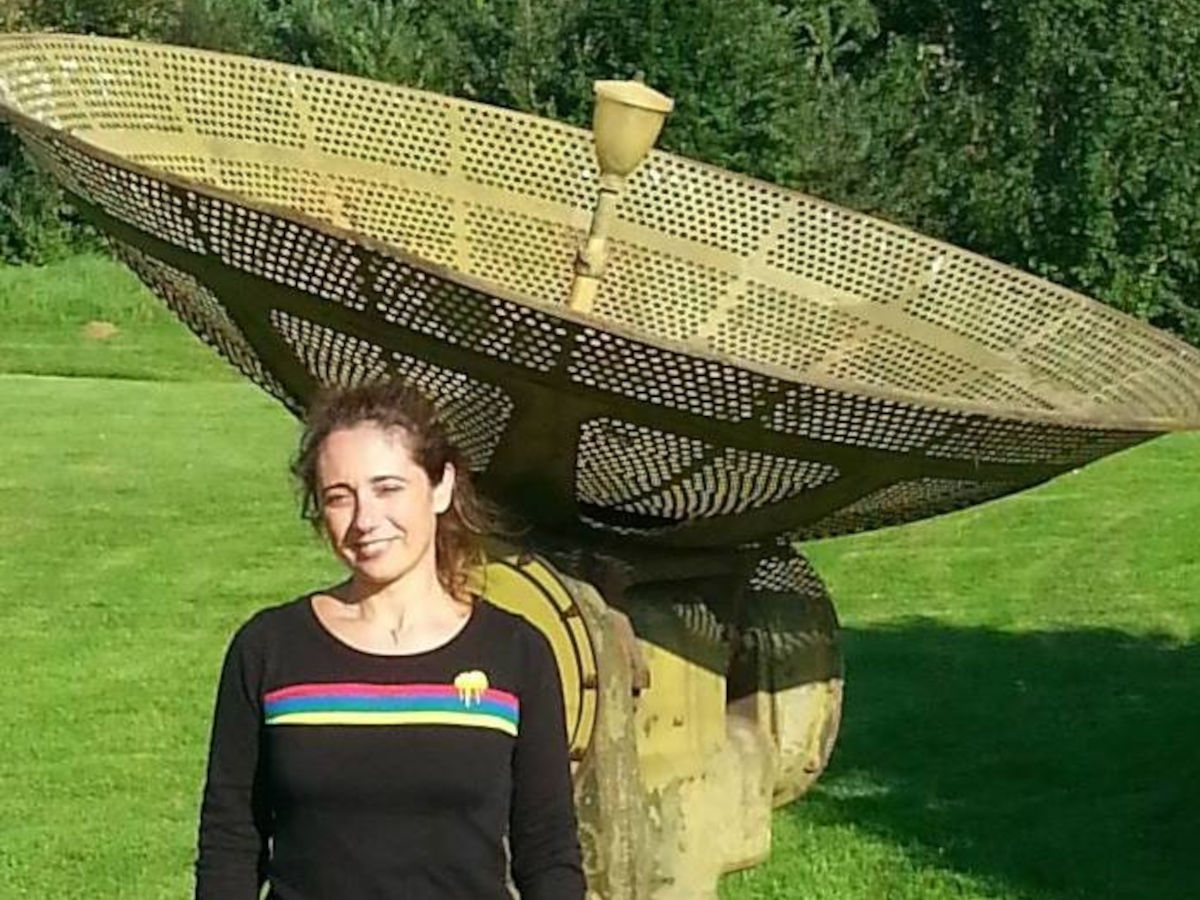
Artist, Astronomers Without Borders
Daniela de Paulis is a media artist, licensed radio operator (IU0IDY) and trained radio telescope operator. From 2009 to 2019 she has been artist in residence at the Dwingeloo radio telescope, where she has developed a large body of work using innovative radio technologies in live performance art. She is member of the permanent international SETI (Search for Extraterrestrial Intelligence) committee, the only worldwide forum for SETI scientists, and member of the METI (Messaging Extraterrestrial Intelligence) advisory panel.
www.danieladepaulis.com
www.cogitoinspace.org
www.opticks.info
Mirjana Povic - Astronomy and Space Science for Development in Africa
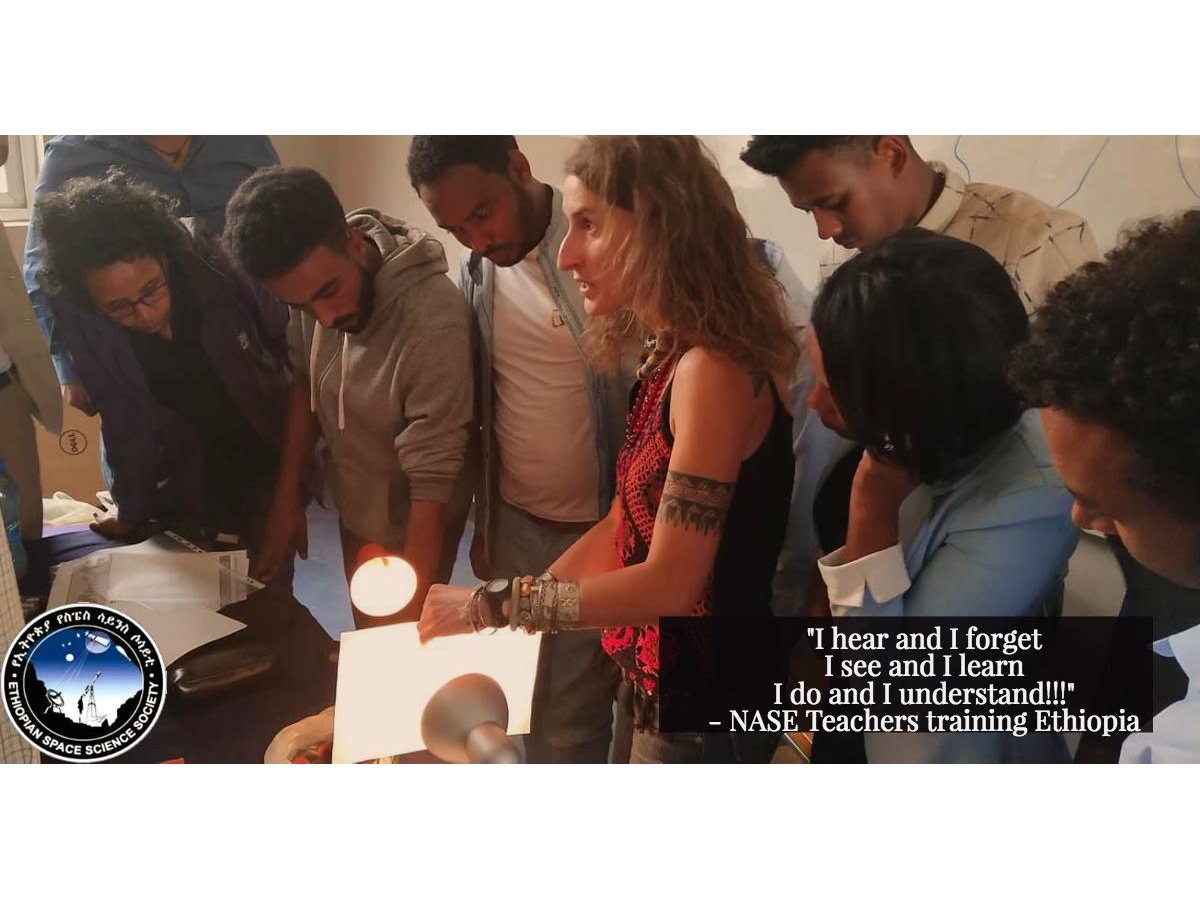
Africa has amazing potential due to natural and human resources for scientific research in astronomy and space science (A&SS). At the same time, the continent is still facing many difficulties, and its countries are now recognizing the importance of astronomy, space science and satellite technologies for improving some of their main socio-economic and ecological challenges. The development of A&SS in Africa has grown significantly over the past years, and never before it was more possible to use astronomy for development as it is nowadays. However, much still remains to be done. This talk will summarise recent developments in A&SS in Africa and will focus on how working together on development of science and education can we fight poverty on the long term, and increase in future our possibilities of attaining the United Nations Sustainable Development Goals for the benefit of all.
Mirjana Povic

Ethiopian Space Science and Technology Institute (ESSTI)
Assistant professor and Head of Astronomy and Astrophysics Research and Development Division, Ethiopian Space Science and Technology Institute, Ethiopia
Associate researcher, Instituto de Astrofisica de Andalucia, Spain Honorary professor, Mbarara University of Science and Technology, Uganda
Mirjana Povic (1981, Serbia) is assistant professor and Head of Astronomy and Astrophysics Research and Development Division at the Ethiopian Space Science and Technology Institute (ESSTI), associate researcher at the Institute of Astrophysics of Andalucia in Spain, and honorary professor at Mbarara University of Science and Technology in Uganda. She obtained her PhD in astrophysics in 2010 at the Institito de Astrofísica de Canarias (Spain). Her main research interests are related with galaxy formation and evolution, in particular with nuclear activity in galaxies, star formation, morphological classification of galaxies, and galaxy clusters. In addition, over more than last 10 years, she worked on development in astronomy, science and education in different parts of Africa, and in particular in Ethiopia, Rwanda, Uganda, Tanzania, South Africa, Kenya, Ghana, Zambia, and Morocco, through joint research collaborations, institutional development, students supervisions, trainings, lecturing, regulation development, and outreach. In 2018 she was a winner of the inaugural Nature Research Award for Inspiring Science. In May 2019 was invited by Serbian Government to be one of 16 selected Science Ambassadors. In June 2019 she received a recognition from the ESSTI and Ethiopian Ministry of Innovation and Technology for her contribution to the institutional development of ESSTI and development of astronomy and science in Ethiopia.
https://www.researchgate.net/profile/Mirjana_Povichttps://www.iau.org/administration/membership/individual/15467/
https://en.wikipedia.org/wiki/Mirjana_Povi%C4%87
Neha Satak - The Unconventional Startup

Vision of a connected world [Credits: Astrome Technologies Private Limited]
Space has been thought of as a sector in which only companies and individuals with deep pockets can succeed. This view is changing due to the determination of several individuals and startups who are changing the mindsets of customers and financiers in their respective countries. This talk will reflect upon our experiences and observations in this context.
Neha Satak

CEO, Astrome Technologies Private Limited
Neha is the co-founder and CEO of a space startup, Astrome, which is working on making high-bandwidth satellite internet connectivity affordable. Astrome through its patented technology is solving the fundamental problem of the absence of quality internet backbone in most parts of the world. She holds a PhD from Texas A&M University and a Masters from Indian Institute of Science (IISc) in Aerospace Engineering. She worked as a Postdoctoral Research Associate at University of Florida in association with the Air Force Research Lab, USA. She was awarded the Amelia Earhart Fellowship by Zonta Foundation and WEQ award jointly by AnitaB.org, USISTEF and Government of India. She was also selected to be part of ITU’s EQUALS program.
For the »All Women Crew » 2020 workshop, we created a deck of cards.
The workshop having been cancelled we have asked each of the participant to « play » remotely. Each participant has been asked to answer the same first question « what has attracted you to space » and then two other questions picked up by chance.
Deck of Cards Proposition & Questions: Annick Bureaud
Cards Graphic Design: Quentin Aurat
Podcasts Sound Design: Jean-Yves Leloup
All Women Crew On the Moon
As the participants to the workshop could not meet in Paris, they decided instead to go to the Moon using Daniela de Paulis Visual Moonbounce technology.

Daniela de Paulis (IU0IDY) initiated and developed the Visual Moonbounce technology as an artistic process in 2009, with the technical support of the CAMRAS team (PI9CAM) based at the Dwingeloo radio telescope in The Netherlands. Over the years the technology and methodology she developed has become increasingly popular amongst international radio operators. For the
« All Women Crew » project, she has been collaborating with fellow radio operators Daniel Gautschi (HB9Q), Nando Pellegrini (I1NDP) and Mario Armando Natali (I0NAA).
Poster design by Quentin Aurat
All Women Crew participated in the exhibition Con(tacto)/ August 15th – September 15th curated by Marta de Menezes at Cultivamos Cultura in Saõ Luis Odemira, Portugal


Partners
All Women Crew has been organised in partnership with FEMeeting With the support of the « Fondation Carasso« , « Canadian Cultural Centre » and « Cultivamos Cultura«





Leonardo/Olats
Observatoire Leonardo des Arts et des Techno-Sciences
À propos / About | Lettre d'information Olats News



Pour toute (re)publication, merci de contacter / For any (re)publication, please contact Annick Bureaud: info@olats.org
Pour toute question concernant le site, merci de contacter / For any issue about the website, please contact: webmaster@olats.org
Design Thierry Fournier
© Association Leonardo 1997-2022
